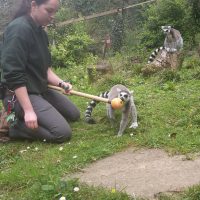 Jade Price is a primate keeper at Combe Martin Wildlife Park in North Devon, England. She has the privilege of spending her working life with three amazing species of lemurs, which is just as well because she describes herself as “totally lemur crazy!” This is the first in a series of posts that will document the many aspects of Jade’s experience working with lemurs in managed care, and the importance of zoos to lemur conservation.
Jade Price is a primate keeper at Combe Martin Wildlife Park in North Devon, England. She has the privilege of spending her working life with three amazing species of lemurs, which is just as well because she describes herself as “totally lemur crazy!” This is the first in a series of posts that will document the many aspects of Jade’s experience working with lemurs in managed care, and the importance of zoos to lemur conservation.
At Combe Martin Wildlife Park we care for a group of ring-tailed, black and white ruffed, and red ruffed lemurs. My role as a zookeeper involves everything from preparing the animals’ food, producing exciting enrichment to present it in, to health checking, cleaning and training our groups of lemurs. Believe me when I say that no day is the same!
Turning My Love of Lemurs into a Career as a Zookeeper
My love of lemurs first manifested four years ago when I began volunteering at a lemur walk-through exhibit at another wildlife park in England.
When I stood in the early morning mist during those cold October Sundays listening to their haunting calls echoing through the trees, I was completely hooked on lemurs.
I find the sheer diversity of the species fascinating and I was desperate to learn more. Landing my first zookeeping job allowed me to work more closely with lemurs and being able to volunteer and work at a number of collections enabled me to understand that each group of lemurs, be it the same species or not, are hugely different from each other personality wise.
I hope that my series will let you in on the secret world of zoo keeping: the day to day life of working with lemurs and the importance of zoos in the survival of their species.
Meet the Lemurs at Combe Martin
At the park we currently house three ring-tailed lemurs, a group of seven black and white ruffed lemurs, and a group of four red ruffed lemurs.
The Three Ring-tailed Lemurs at the Zoo
When I first started my zookeeping position on the primate section, I was in charge of training the ring-tailed lemurs. So let me start by introducing you to the three cheeky musketeers. In the troop we have two males, Popeye and Spike, and one female, Mae.
Popeye is the cheeky chappy of the group, easily distinguished by the fact he is missing one of his eyes. His depth perception is generally very good and does not inhibit his training, though he does have off days when he instead of jumping past you, you end up with a lemur to the face.
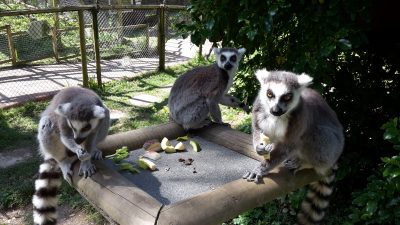
Spike is the quiet withdrawn individual within the group who spooks easily and the concept of new things often gets him on edge.
Mae is our female ring-tailed lemur. As with many lemur species the females are the dominant ones. When I first started working with them however I quickly realized that Mae was not like the usual bold, dominant females I had previously worked with at other collections. Mae was very reserved and avoided coming too close to keepers if she could help it.
Breeding Lemurs
This group is a breeding group but unfortunately we have not had any infants so far. Ring-tails do however breed very well in managed care; if you’ve visited zoos and wildlife parks in Europe or North America, you will undoubtedly have seen ring-tailed lemur families in most of them. But pregnancy always runs the risk of being a complicated business and something that as keepers is crucial we monitor through every stage of its process. This begins with the initial problem of the belly bulge.
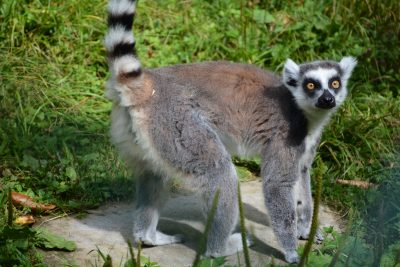
Lemurs have an average gestation period of around five months but the problem lies in the fact that females don’t tend to physically show their pregnancy until the last few weeks before the infant is born. By the time you’ve discussed with your colleagues whether the individual in question has a growing paunch or not, it’s often too late and one morning you have surprise baby lemurs! Cue the essential role of training.
Training Lemurs is an Essential Part of My Job
Training is an essential part of our careers as zookeepers; they are vital to easing the performance of important health checks, lessening the stress of traveling or visits to the vets, and just as importantly, cognitive stimulation. At Combe Martin, we use the positive reinforcement training method with all our animals. This means that we ask an animal to carry out a certain behavior and reward it when it does so. It is important to know that we do not force the animals to participate in these training sessions, and should they want to stop at any time we allow them to and never punish any negative behavior, hence the name of reinforcing the positives.
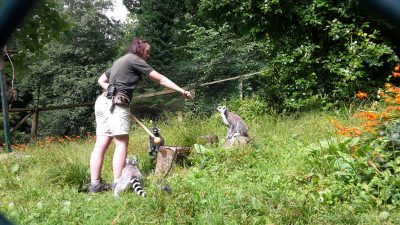
Positive reinforcement is also great for building up relationships between animals and their keepers; as keepers we spend most of our waking lives with these animals from scooping their poop to staying up all hours to watch infants coming into the world. So having a connection and level of trust makes our jobs a hell of a lot easier and in turn, the animals’ lives less anxious or stressful when it needn’t be. That’s not to say it’s easy though.
Getting Started with Target Training
As their trainer, the first thing I wanted to introduce was target training. Lots of keepers have different tools and instruments for target training from sticks to boards to clickers and whistles. For my group I decided to introduce a stick with an orange tennis ball attached to the end as their ‘target point’. I used a clicker – just like those used for training dogs – as what we call a ‘bridge’ implement. The clicker is sounded every time the desired behavior is carried out and is instantly followed by a high quality food reward to allow the animal to link together the idea that performing that certain behavior gets them a nice treat.
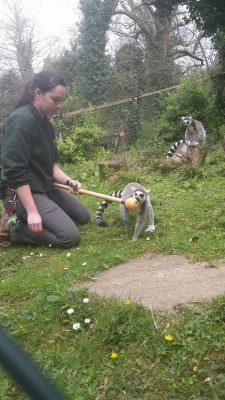
My aim was to get all three ring-tails to target the ball on the end of the stick to enable me to get them to sit in separate places with the hope of eventually introducing a set of weighing scales. My hope was that not only could I keep a record of their weights for health reasons but I would also to be able to monitor Mae’s weight so that after breeding season – around November – I would be able to have a better idea as to whether or not she has become pregnant – watching for the tell tale yet discreet increases in weight.
The Lemurs Became My Star Pupils
When I entered their enclosure for the first time, armed with my clicker, target stick and a pocket full of peanuts – their absolute favorite – I was positive yet not expecting miracles. Given that the majority of the group freaked out at blackbirds moving leaves in their undergrowth I was prepared for the long haul of building up their trust and dissuading the fear of the unknown. What I wasn’t expecting was what happened next.
My aim was to simply get the group to come over to me, with the stick at my feet, and take peanuts from my hand with just the presence of the training equipment. Popeye however had different dreams of grandeur. Showing a lot of interest in the target stick, I offered the orange tennis ball out to him. He instantly grabbed it with his hand and investigated it. I clicked my clicker and rewarded him with a peanut for touching the ball. Whilst the clicker noise momentarily spooked Spike and Mae – who retreated into the trees to watch from afar – Popeye barely reacted.
Due to our busy schedule on the primate section I normally only get between five and ten minutes training with the ring-tails. By my third session Popeye had learnt not only to touch the ball, but to only touch it with his nose not his hand and was following it to wherever I pointed it. The reason behind touching it with their noses is to prevent them holding onto the stick whilst standing on the scales and therefore giving an incorrect reading.
Fast forward three weeks and I had the boys sitting on two of the three training tree stumps I had set up. Mae had by now decided to sit close by and watched the boys very intently. During the end of the third week she sauntered over, touched the ball with her nose and then sat down, complying with my newly added ‘wait’ command.
Ring-tails are reported to be one of the more intelligent members of the lemur species, and they were certainly proving that theory right!
Advancing their Training
A month on I was thrilled to have all three ring-tails coming over to automatically sit on their designated training stump, or ‘station’ and confidently ‘waiting’ there. The next stage would be the hardest, getting one lemur to now come off that stump and onto a fourth one with a set of scales in. Working with the confident Popeye initially, I found he was more than obliging to target the ball down off his stump and onto the floor, and then to station back on his stump when asked. I hit a problem however; when Popeye left his stump Spike would jump onto it, eager to sit a bit further away from Mae who they are always wary of, being the dominant female. I decided I had to move his stump a little further away from Mae’s. This caused a great deal of panic and alarm.
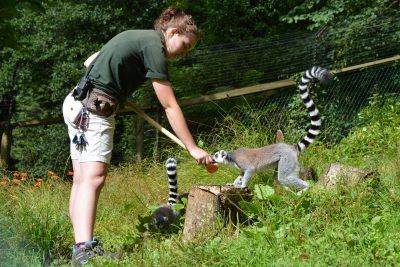
Even though the stump had only shifted 1.2 inches to the left all chaos ensued. There was much alarm calling, clicking and head bobbing at the ‘new’ stump and though they wanted to train, the newness of the scene saw training cancelled for three whole days while they got over the shock. Eventually calm returned and all was forgotten. Training continued to be hugely successful and I knew what it felt like to be a proud parent…of sorts. So I decided it was time for the big leap, and to introduce the fourth stump with the weighing scales set in.
Building Up to a Breakthrough
This takes me to the current day. Surprisingly the fourth stump was added to the enclosure with no fuss whatsoever. Primates! I then decided to go whole hog and try their first training session with the new stump with the scales in as well. A dangerous risk.
Setting the scales in place I asked the group over as normal. Much to my amazement we had total role reversals. Scaredy Spike who, when spooked during training, normally won’t come and station again for that day, came and sat by my feet and sniffed the control pad of the scales. I couldn’t believe he’d come over let alone show comfort around it. To further my surprise Popeye was totally unnerved by the whole set up, whereas Mae made the first tentative stretch onto the scales.
With further encouragement of peanuts and vocals from me, she made it fully onto the scales allowing me to see for the first time her elusive weight! Had I not been surrounded by nervous lemurs and many members of the public looking on in fascination I would have fist pumped and whooped loudly. Eventually I got Popeye to come onto the scales, bar one foot which he was reluctant to tuck up. This was such an incredible breakthrough and one that I am looking forward to updating you on as their confidence hopefully grows.
In my next post I hope to tell you a little about the weight training that all the ruffed lemurs are newly taking on – it involves sticks, luggage weights and plenty of lifting!
Learn More
- Learn more about and support the Combe Martin Wildlife Park
- Explore and support conservation projects that work to protect ring-tailed lemurs in the wild
